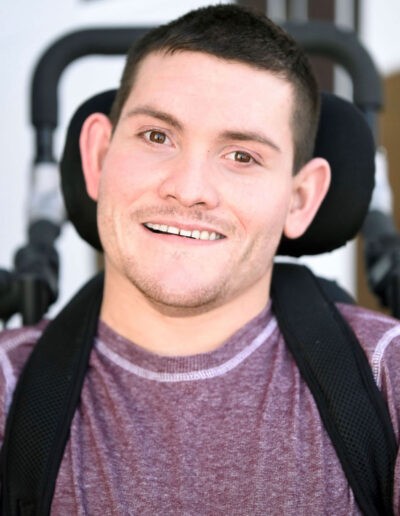Enzymes
Living cells are complex structures, which manage an unending stream of chemical reactions. Some chemicals are broken down to provide energy (think of “burning” sugar to fuel the body) while others are built up into more complex structures. All of these reactions are made to happen by large protein molecules called enzymes. Chemists call enzymes biological catalysts but, if you are not a chemist, a good analogy might be a robotic assembly line in a factory. As the raw materials move down the line, each step adding a new part, the machines doing the work process each piece as it comes along and sends it on to the next machine. Enzymes are like those machines and like the machines, they are organized in pathways.
Proteins are made of simple chemicals called amino acids, which are joined to make chains hundreds of amino acids long; the chains fold up to produce wonderfully complicated three-dimensional structures, which can hold and manipulate the chemicals that flow through their pathways in the cell. Genes are nothing more than codes that the cell can read to know which amino acids go in which order to make the proteins. A mutation in a gene leads to the wrong amino acid being put into the chain so that the enzyme ‘machine’ doesn’t work as well.
NADPH
NADPH is a chemical compound that stands for Hydrogenated Nicotinamide Adenine Dinucleotide Phosphate. There is another form called simply Nicotinamide Adenine Dinucleotide Phosphate and abbreviated NADP. This pair of chemical compounds is cofactors or coenzymes for the enzyme Glucose-6-Phosphate Dehydrogenase. When the enzyme converts glucose-6-phosphate to another sugar called 6-phosphogluconate it simultaneously converts NADP to NADPH. It does this by transferring a hydrogen atom, ‘H’ from the sugar to the coenzyme. This can then take the hydrogen atom away to participate in other reactions in the cell including the reactions that protect against oxidative stress.
The nicotinamide part of NADP(H) is derived from the vitamin Niacin (nicotinamide or nicotinic acid).
Oxidative Stress
Oxidative stress sounds like an oxymoron: isn’t oxygen required for life? How can it cause stress? The fact is, however, that the oxygen molecule is so reactive that it requires special handling for living organisms to avoid being damaged by it. The reward, of course, is that oxidizing foodstuffs delivers more energy for the organism to use so it is worth all the trouble. The red blood cell is especially at risk because its whole job is to ferry oxygen around the body bound to hemoglobin.
In the normal red cell, a small amount of active oxygen is continuously formed either as an oxygen radical or hydrogen peroxide. If allowed to accumulate, these substances will damage the cell in multiple ways. When you remember that hydrogen peroxide is used as a disinfectant because of its ability to kill bacterial cells, it becomes obvious that the cell needs to have some way to remove it or destroy it. There are two mechanisms for doing this: either with an enzyme called catalase or a chemical called glutathione which is oxidized by reactive forms of oxygen and then reduced again in a reaction using NADPH — the cofactor produced by G6PD. In fact, that is why G6PD exists in the red cell: to produce NADPH for use in keeping the level of glutathione high to keep the level of reactive oxygen low.
Normally, there is a huge reservoir of anti-oxidative capability in the red cell; G6PD is thought to only work at about 1 or 2% of its capability. However, when there is some situation that causes more reactive oxygen to form, the protective mechanisms are able to generate more anti-oxidant capacity. This can happen when certain drugs or other chemicals are present in the circulation and also when the white cells are fighting infection. In people with severe G6Pd deficiency, their red cells’ ability to cope with extra reactive oxygen can be overwhelmed leading to the red cell damage that is characteristic of the acute hemolytic anemia seen.
Proteins, Genes and Chromosomes
The cells of your body are largely made up of a host of different proteins. Some proteins are structural but most are enzymes. Proteins are themselves made up of a chain of amino acids. There are twenty different amino acids; the structure and function of any protein are determined by which amino acids in which particular order make up the sequence. The amino acid sequence is in turn specified by the order of four different bases found on DNA. Each amino acid is specified by a particular set of three bases and the correspondence of each of these triplets to the amino acid each one specifies is what we call the genetic code.
Oversimplifying somewhat, a gene is a stretch of DNA carrying the code for a particular protein. A chromosome is a huge stretch of DNA that comprises many genes in a specific order, rather like a carefully arranged string of beads. The cell has intricate machinery for “reading” the code of a gene and translating it into the corresponding protein.
Mutations
Whenever a cell divides, its chromosomes must be copied. Sometimes mistakes are made in the process and these mistakes are called mutations. Some mutations will entirely wreck a particular gene and functional protein cannot be made from that gene. Frequently, however, the mutation is just the replacement of one amino acid by a different one. If the mistaken amino acid is not chemically too different from the original one, the protein can still be made and still be able to function but perhaps less well.
If the copying mistake happens during the process leading to the production of a gamete (ovum or sperm cell) and that gamete goes on to become part of a fertilized cell (zygote) the offspring will now have the mutation in every cell. At this point the patterns of inheritance described in the section “Did I inherited it?” will explain how future generations will inherit the mutated form of the protein.
Prevent Kernicterus
Our babies were born healthy. Mismanaged newborn jaundice then led to a lifetime of disability. The K word happened. Join us. Prevent the K. Cure the K. (Kernicterus can happen when acute bilirubin encephalopathy is allowed to occur.)
Parents of Infants and Children with Kernicterus, PICK, is a parent-run non-profit on a mission to kick the K. Understanding our organization means understanding that Jaundice can cause irreparable harm.
Mismanaged Jaundice caused the K (kernicterus).









